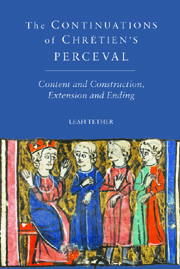Book contents
- Frontmatter
- Contents
- Acknowledgements
- Abbreviations and MS Sigla
- Introduction
- 1 Authorial Changeovers in the Manuscripts
- 2 Distinguishing Continuations, Sequels and Ends
- 3 The First Continuation and Prolongation
- 4 The Second Continuation and the Imitative Mode
- 5 The Gerbert and Manessier Continuations: Interpolation vs. Conclusion
- Conclusion
- Appendices
- Bibliography
- Index
- ARTHURIAN STUDIES
2 - Distinguishing Continuations, Sequels and Ends
Published online by Cambridge University Press: 05 February 2013
- Frontmatter
- Contents
- Acknowledgements
- Abbreviations and MS Sigla
- Introduction
- 1 Authorial Changeovers in the Manuscripts
- 2 Distinguishing Continuations, Sequels and Ends
- 3 The First Continuation and Prolongation
- 4 The Second Continuation and the Imitative Mode
- 5 The Gerbert and Manessier Continuations: Interpolation vs. Conclusion
- Conclusion
- Appendices
- Bibliography
- Index
- ARTHURIAN STUDIES
Summary
What is a ‘Continuation’?
In the most general sense, of course, everyone would understand the word ‘Continuation’. It implies, one would assume, an ‘unfinishedness’, or incompletion, in the initiating narrative: it may be that the ultimate fates of some of the protagonists are unknown, but intriguing; it may be that a narrative thread is left hanging; it may be that some objective set for the protagonists is unfulfilled; it may be that there are mysterious events which seem to want explanation. A ‘Continuation’, in other words, fulfils the audience's, or the reader's, expectations, and ensures that their curiosity is fully and perfectly satisfied. As Renate Blumenfeld-Kosinski says, pertinently, in relation to the Voeux du Paon cycle:
a continuation is designed to fill some gap in the narrative material. The perception of the exact location of this gap and of how it can be filled may differ depending on when and by whom the text is read, but some general tendencies can be discerned. On the most basic level any audience will feel dissatisfied if one or several of the protagonists are abandoned before their destiny is fulfilled. […] the poet feels compelled to satisfy the expectations of his audience – a perfect articulation of the medieval Erwartungshorizont.
However obvious this seems, the trouble is this definition is not quite specific enough to deal with what it is conventional to call ‘a Continuation’, as it might also seem to refer to other narrative forms.
- Type
- Chapter
- Information
- The 'Continuations' of Chrétien's 'Perceval'Content and Construction, Extension and Ending, pp. 57 - 108Publisher: Boydell & BrewerPrint publication year: 2012

